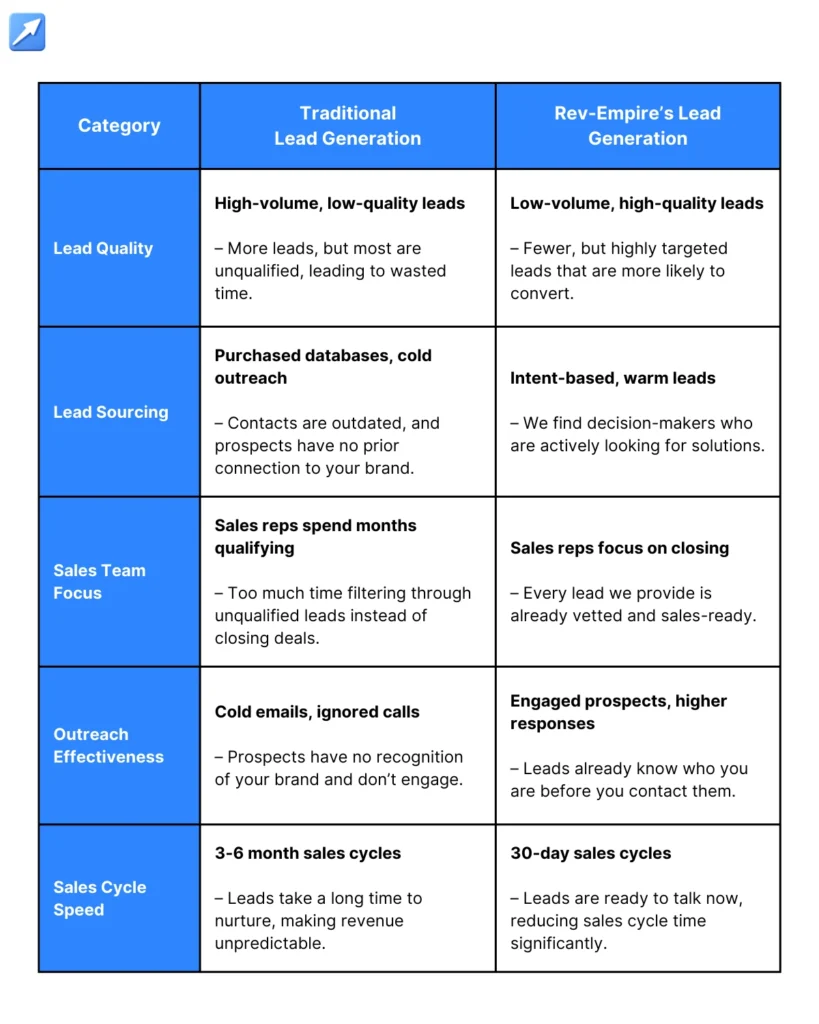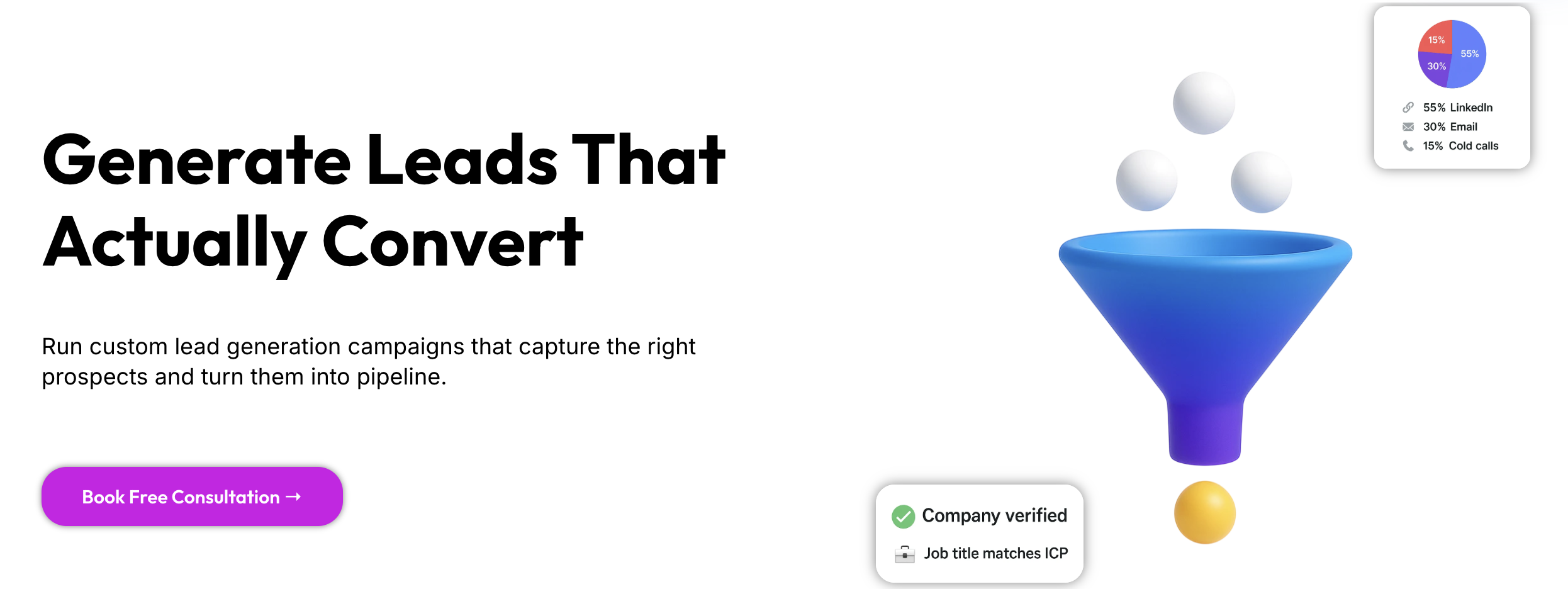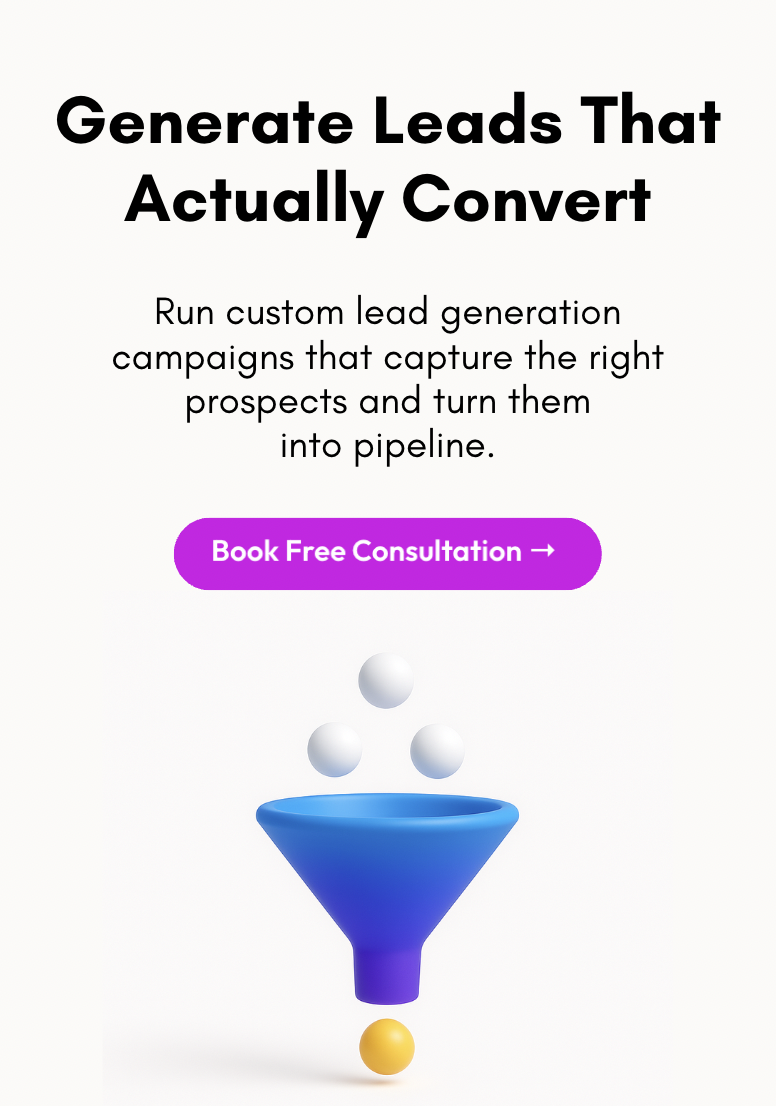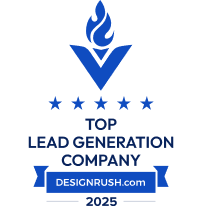Lead Generation Done Differently: The Difference Between Traditional and
Rev-Empire’s Approach
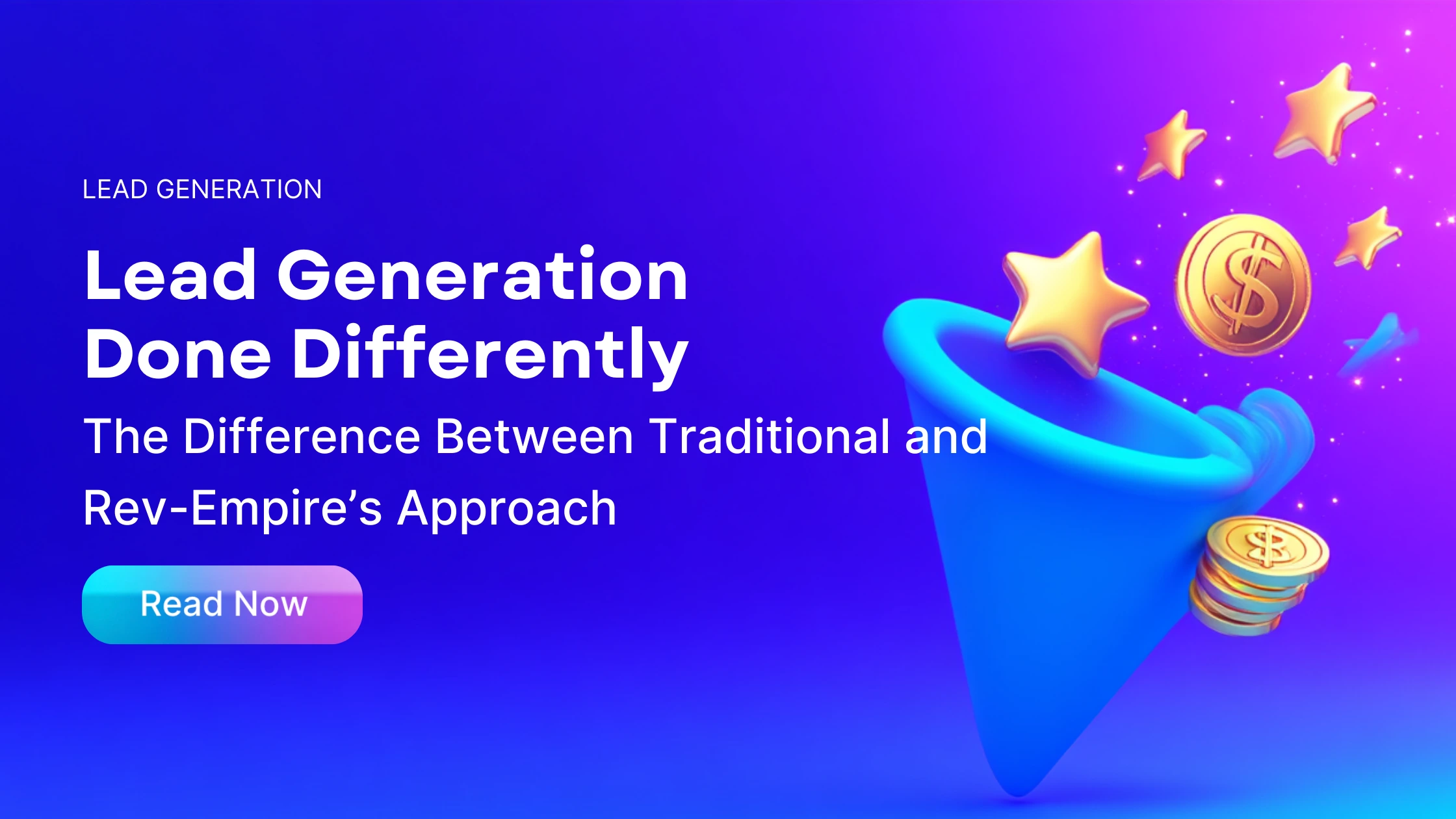
📅 Published: February 12, 2025 | ⏱️ 8–10 min read
Introduction: Why Another Lead Gen Company?
We have often been asked:
“Aren’t there already too many lead generation companies? What makes Rev-Empire different?”
It’s a fair question. Businesses today have endless options for lead generation, yet the same frustrations keep coming up—wasted time on leads that don’t convert, sales teams chasing cold prospects, and unpredictable pipelines that stall growth.
We saw an opportunity to do things differently—to create a process that actually moves businesses forward. That’s why we built Rev-Empire, a lead generation approach that delivers real revenue opportunities, not just more names on a list.
In this blog, we’ll share:
- What we’ve learned about the challenges of traditional lead generation.
- How our approach prioritizes quality over volume.
- A direct comparison of traditional lead gen vs. our process.
- Key insights to help businesses refine their lead generation strategy.
Challenges with Traditional Lead Generation
Many businesses assume that more leads mean more sales. On paper, it makes sense—the bigger the pipeline, the better the chances of closing deals. But in reality, lead quantity doesn’t translate to revenue if those leads aren’t the right fit.
Traditional lead generation often prioritizes volume over relevance, leaving sales teams overwhelmed with contacts that don’t convert, don’t respond, and don’t move the business forward. Instead of creating real opportunities, it creates more work, longer sales cycles, and lower success rates.
1. A Full Pipeline Doesn’t Mean More Revenue
Many lead generation providers focus on filling the sales pipeline with as many contacts as possible. At first glance, this looks promising—more leads should mean more deals, right? But we’ve seen time and again that a bloated pipeline often creates more work, not more revenue.
- Most leads aren’t decision-makers and lack the budget or authority to move forward, wasting valuable sales time.
- Outdated lead lists lead to dead ends—many contacts have changed roles, switched companies, or are no longer relevant.
- Sales teams spend more time qualifying than closing, filtering through low-quality leads instead of focusing on high-value conversations.
Instead of accelerating sales, an overloaded pipeline often slows everything down, making sales teams less efficient.
2. Cold Outreach Without Context Gets Ignored
Cold calls and mass emails used to be standard lead generation tactics, but today’s buyers expect relevance and personalization. They research before engaging and ignore generic outreach.
- Mass emails go unread when they lack personalization and don’t immediately provide value.
- Cold calls rarely connect because decision-makers are busy and don’t respond to brands they don’t recognize.
- Prospects are more likely to engage with brands they trust, making visibility and credibility essential before outreach begins.
This approach turns lead generation into a numbers game—sending as many messages as possible and hoping for a response. But hope isn’t a strategy. The real key is reaching the right people, with the right message, at the right time.
3. Long Sales Cycles Slow Down Growth
Many businesses struggle with slow-moving sales cycles. Instead of quick, meaningful interactions, leads require months of follow-ups before they even consider moving forward. Why? Because most traditional lead gen tactics target prospects too early in their decision-making process.
4. Poor Lead Qualification Overwhelms Sales Teams
Many lead generation services take a one-size-fits-all approach, delivering large lists of contacts without considering whether they are the right fit. Instead of providing sales-ready leads, these services pass the burden onto sales teams, who then have to sort through irrelevant contacts, chase unresponsive prospects, and waste valuable time on leads that will never convert.
- Sales teams spend hours manually filtering leads instead of focusing on high-value conversations.
- Outreach efforts are wasted on prospects who have no real interest or need for the product.
- Without clear qualification, businesses struggle with unpredictable revenue, as conversion rates remain low and inconsistent.
- Sales teams face constant frustration and inefficiency, leading to burnout and slower deal closures.
Without a structured process to qualify and vet leads before they reach sales, businesses lose time, resources, and potential revenue—turning lead generation into an expensive guessing game rather than a predictable growth driver.
Rev-Empire’s Approach To Lead Generation
Traditional lead generation often prioritizes quantity over relevance, leaving businesses overwhelmed with unqualified leads, long sales cycles, and unpredictable revenue. We take a different approach—one designed to connect businesses with the right people, at the right time, with the right message. Instead of focusing on sheer volume, we ensure that every lead is engaged, informed, and more likely to convert.
1. Finding Leads Who Are Already Interested
Rather than starting with a random list of names, we focus on identifying buyers who are actively researching solutions. Instead of trying to create demand where it doesn’t exist, we tap into existing interest and buying intent.
- We track industry engagement to find decision-makers already exploring relevant solutions.
- We monitor buying signals—for example, companies expanding their teams in specific roles often indicate an upcoming need for new tools and services.
- We analyze market trends and competitor activity to understand where demand is growing.
This ensures that businesses connect with prospects who are already considering a purchase, leading to faster sales cycles and more meaningful conversations.
2. Warming Up Leads Before Outreach
Cold outreach without prior engagement rarely works anymore. Buyers today are bombarded with messages and are far more likely to respond when they already recognize the brand reaching out to them. That’s why we take steps to increase awareness before direct outreach happens.
- We engage with potential leads through targeted content and social interactions to establish familiarity.
- We ensure prospects see relevant thought leadership and brand messaging before receiving a direct approach.
- We leverage referral-based introductions wherever possible to create a more natural and trusted connection.
By the time we reach out, prospects are already aware of our clients’ value, making them far more likely to respond.
3. Personalized, Human-Led Outreach
Mass, automated outreach often results in low engagement and high rejection rates. We take a human-first approach, ensuring every interaction is relevant, meaningful, and value-driven.
- We customize every message to align with the recipient’s industry, role, and challenges.
- We focus on starting conversations, not just making a pitch—understanding a lead’s specific needs before offering solutions.
- We adjust our messaging based on previous interactions, ensuring that every touchpoint builds on the last.
This approach leads to higher response rates, better sales conversations, and stronger relationships. Instead of treating lead generation as a numbers game, we focus on quality interactions that move deals forward.
4. Aligning Sales and Marketing for Better Results
Many businesses struggle with lead generation because sales and marketing teams operate in silos. Marketing generates leads, but sales teams often find them unqualified or not ready to convert. Without a clear alignment, the entire process becomes inefficient—wasting resources and slowing down growth.
A lack of coordination leads to:
- Poor lead qualification – Marketing hands over leads that sales teams don’t see as valuable, leading to wasted follow-ups.
- Ineffective messaging – Sales and marketing communicate different narratives, making it harder for prospects to understand the value proposition.
- Inefficient handoffs – Leads enter the pipeline before they’re ready, forcing sales teams to chase contacts that aren’t primed for conversion.
We ensure that sales and marketing work together, aligning their strategies to create a lead generation process that delivers real sales opportunities—not just names on a list. By improving lead qualification, synchronizing messaging, and ensuring a smoother handoff, businesses increase conversions, shorten sales cycles, and maximize ROI.
5. Tracking, Optimizing, and Improving Over Time
Lead generation isn’t a one-time effort—it’s a process that requires constant refinement to remain effective. Many companies set up a lead generation system and assume it will keep producing results, but without continuous monitoring and adjustments, strategies become outdated, and lead quality declines.
To maintain strong performance, we:
- Track key performance indicators (KPIs) such as conversion rates, engagement levels, and pipeline movement to measure effectiveness.
- Refine targeting criteria based on real-time data, ensuring we always reach the most relevant prospects.
- Adapt messaging and outreach strategies to stay aligned with market trends, industry shifts, and buyer behavior.
By consistently analyzing results and making improvements, businesses see long-term growth, more predictable revenue, and a lead generation system that continues to perform at a high level. Instead of relying on guesswork, companies can scale with confidence, knowing their lead generation strategy is always optimized for success.
Summary: The Differences between Traditional Lead Gen And Rev-Empire Lead Generation
How Are We Able to Do This?
Delivering high-quality, engaged leads isn’t just about having a great strategy—it’s about how we execute it every single day. We don’t rely on mass automation or generic outreach. Instead, we have built a process that allows us to adapt, optimize, and ensure that every lead is worth pursuing. Here’s exactly how we do it:
1. We Have Carefully Designed Our Process for SMEs
We structure every lead generation campaign to be highly customized and adaptable to ensure we are reaching the right people effectively.
- We begin with a kickoff session where we work with the client to define the exact customer profile, industry segments, and outreach strategy.
- We build custom lead lists manually, verifying each prospect’s role, company relevance, and decision-making authority before outreach begins.
- Before launching outreach, we test different messaging variations on a small segment to see what resonates best.
- If responses indicate misalignment, we immediately refine the targeting criteria instead of waiting weeks to see results.
By constantly adjusting our process in real time, we ensure that every campaign is targeted, relevant, and optimized for engagement.
2. We Keep Our Team Lean to Maintain High Execution Quality
We deliberately run small, focused teams for each campaign so we can stay deeply involved in execution.
- Each campaign is handled by 2-4 people: a campaign lead, researcher, and outreach specialist(s) who directly manage all aspects of lead generation.
- The campaign lead monitors performance, refines messaging, and ensures lead quality before passing prospects to the client.
- The researcher updates lead lists weekly, verifying contact accuracy and ensuring that new opportunities are continuously added.
- The outreach specialist(s) execute personalized emails, track responses, and manage follow-ups manually, adjusting messaging based on engagement trends.
This structure allows us to quickly identify issues, refine outreach, and ensure no lead is wasted.
3. We Run Internal Daily Reviews and Regular Client Check-ins
We track campaign performance in real time, making continuous adjustments based on data.
- Every day, we check open rates, response rates, and lead engagement to identify patterns early.
- Every week, we conduct an internal review to discuss trends, messaging effectiveness, and potential targeting adjustments.
- Every bi-weekly or monthly, we meet with the client to review insights, gather feedback, and make real-time adjustments to outreach strategy and messaging.
- If a lead segment isn’t responding, we immediately pivot—adjusting the outreach approach rather than waiting for the full campaign to play out.
By constantly monitoring performance, we make changes in days, not weeks—ensuring outreach stays relevant and effective.
4. We Ensure Outreach Feels More Personal by Creating Familiarity First
Before reaching out to leads, we take steps to increase brand recognition so prospects are more likely to engage.
- We request clients to create email addresses under their domain for outreach, so messages come from their company instead of an external agency.
- We engage with prospects’ LinkedIn posts or relevant industry discussions before direct contact to build familiarity.
- We track who has interacted with the client’s website or content and prioritize outreach to those leads first, increasing response rates.
- Instead of sending immediate cold pitches, we start with warm-up emails or introductory messages that provide value before making an ask.
This approach ensures that when we reach out, prospects recognize the brand and are more likely to engage.
5. We Only Pass Along Sales-Ready Leads—No Wasted Time
We focus on delivering leads that are actually ready for a conversation, rather than just filling a list with random contacts.
- Every lead is vetted through direct interactions before being passed to the client—no mass lead dumping.
- We track how many times a lead has engaged with our emails or responded to previous outreach before marking them as sales-ready.
- If a lead doesn’t engage initially, we don’t remove them—we adjust the outreach timing, messaging, or method before trying again.
- We provide a lead handover summary with notes on what the prospect has responded to, how they engaged, and what the next step should be.
This means sales teams receive real opportunities, not just a list of names.
6. We Stay Involved Even After Leads Are Handed Over
Unlike most providers who stop after lead delivery, we stay engaged to ensure those leads turn into revenue.
- We track the progress of handed-over leads, ensuring we understand where they are in the sales cycle.
- If certain objections keep coming up, we adjust outreach messaging to address them proactively in future interactions.
- If a lead isn’t ready to convert now, we move them into a long-term follow-up strategy, ensuring they stay engaged until the right moment.
- We provide ongoing support to sales teams, helping them refine their approach based on lead responses and trends.
By staying involved, we help businesses maximize conversions instead of just generating leads.
Conclusion: A More Effective Approach to Lead Generation
We believe lead generation should make sales teams more productive, not more overwhelmed. By focusing on high-intent, pre-engaged leads, businesses can shorten sales cycles and spend less time chasing unqualified prospects.
If you are looking for a lead generation strategy that delivers real, sales-ready opportunities, we’d be happy to discuss how our approach can help.
Categories
Recent posts
Share on socials


